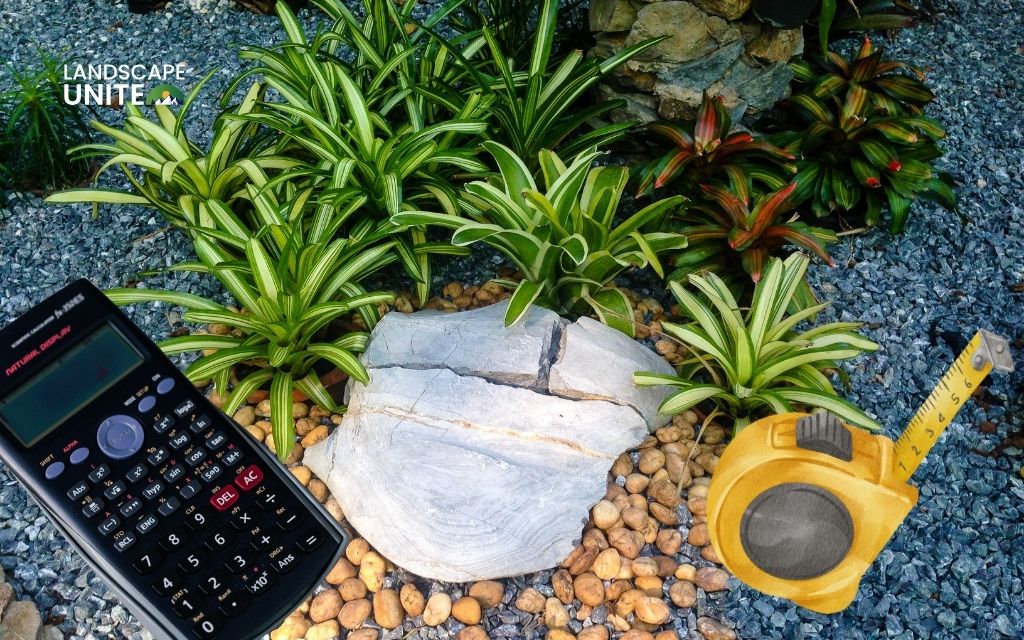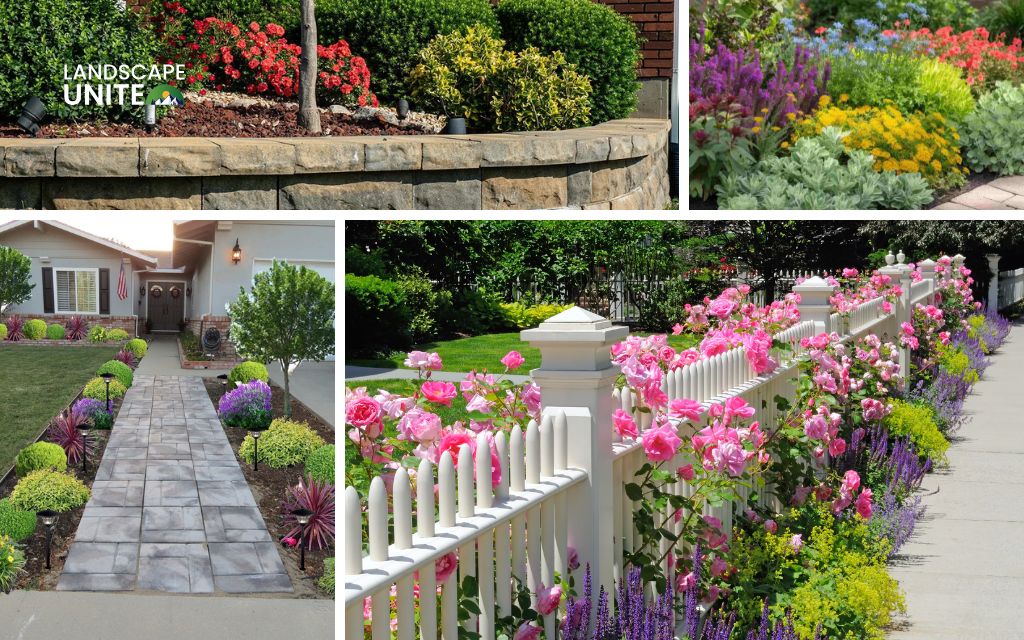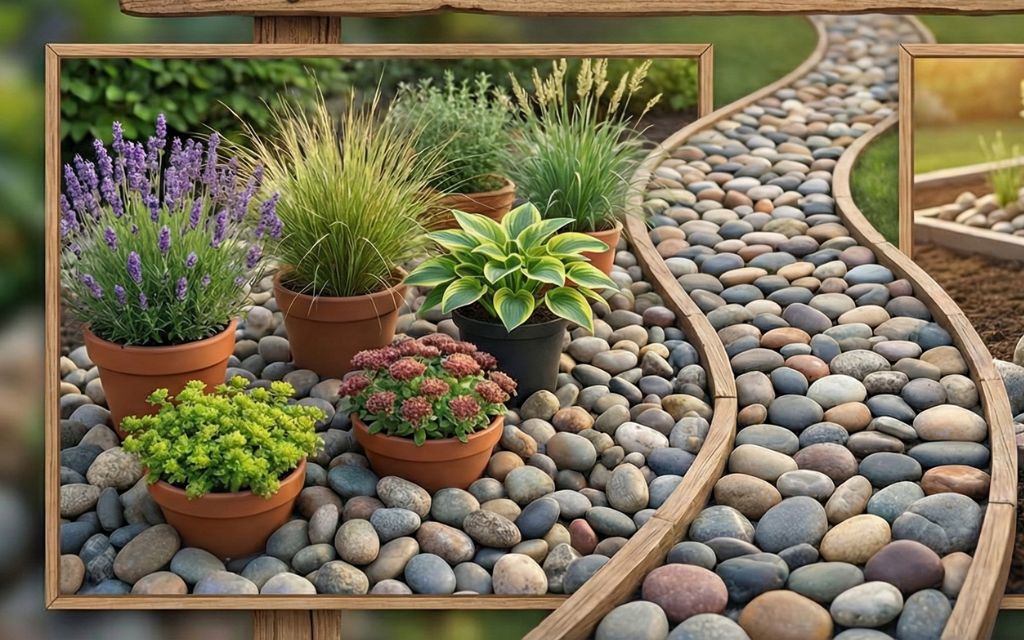Picture a garden overflowing with delicate foxgloves, fragrant roses climbing weathered fences, and butterflies dancing between clumps of lavender. That’s the magic of a cottage garden – a charming style that’s captured American hearts and transformed countless backyards from coast to coast.
Unlike formal gardens that demand precision and constant maintenance, the cottage style garden celebrates abundance, welcomes happy accidents, and actually gets better with age.
In this guide, you’ll discover everything you need to know about cottage garden plans from scratch. We’ll walk through site evaluation, plant selection, layout design, and practical tips that’ll help you cultivate that dreamy English countryside charm – no matter where you live.
By the end, you’ll have the confidence to start planting your own romantic retreat.
What is a cottage garden?
The cottage garden style traces its roots back to the English countryside, where working-class families mixed vegetables, herbs, and flowers in delightfully informal arrangements.
These gardens served a dual purpose: feeding families while beautifying humble homes with whatever plants thrived in the local soil.
Today’s cottage garden design embraces that same unpretentious spirit. Key features include dense, layered planting that creates a lush, “lived-in” look, mixed textures from soft foliage and bold blooms, and romantic color schemes dominated by pastels, whites, and pops of vibrant color.
What sets cottage gardening apart from modern or formal gardens?
While contemporary landscapes often feature clean lines, geometric beds, and carefully spaced specimens, cottage style gardens blur boundaries with plants spilling onto pathways, annuals popping up in unexpected spots, and an overall sense that nature’s been given a welcoming invitation to collaborate in the design.
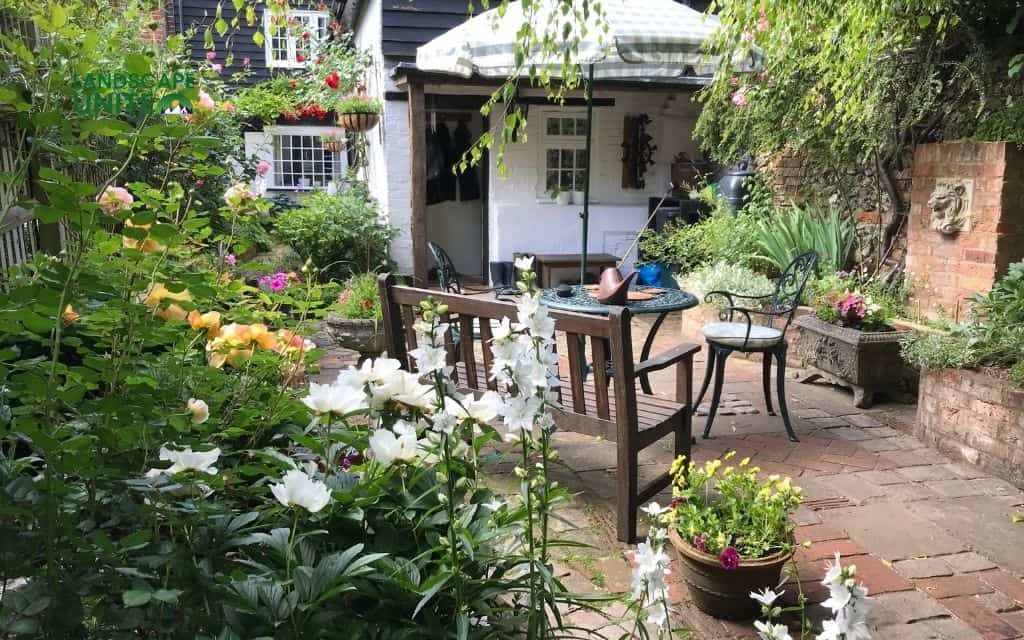
Planning a cottage garden: Step-by-step
Creating your cottage garden plans doesn’t require a degree in horticulture – just thoughtful planning and a willingness to experiment.
Let’s break down the process into manageable steps.
Evaluate your space
Before ordering a single seed packet, spend time getting to know your garden’s unique conditions.
Observe sunlight patterns throughout the day – most cottage flower beds thrive with at least 6 hours of direct sun, though you can design cottage garden plans for partial shade using hostas, astilbe, and bleeding hearts.
Check your soil quality by digging down 6 to 8 inches. Is it sandy and fast-draining, or heavy clay that holds moisture? Cottage gardens are surprisingly forgiving, but understanding your soil helps you choose plants that’ll flourish rather than struggle. Test drainage by digging a small hole, filling it with water, and seeing how quickly it drains.
Consider existing structures like fence lines that beg for climbing roses, pathways that could benefit from fragrant edging plants, or blank walls perfect for vertical gardening.
Choose a style or theme
While cottage gardens feel spontaneous, starting with a loose theme helps create cohesion.
- The classic English romantic style features soft pastels – pinks, purples, blues, and whites – with traditional favorites like roses, delphiniums, and peonies taking center stage.
- For a more naturalized look, wildflower cottage garden ideas incorporate native plants and prairie-style perennials that attract pollinators while requiring minimal fussing. This approach works beautifully in hot, dry regions where water conservation matters.
- The herbaceous and edible cottage garden blends ornamental blooms with productive plants, for example, purple cabbage nestled beside pink cosmos, or strawberry plants cascading from containers surrounded by cheerful marigolds.
- Try a white cottage garden featuring only white and cream blooms with silver and green foliage. The monochromatic palette creates a sophisticated, moonlit-garden effect while maintaining that romantic cottage feel.
Map out a loose layout
The beauty of designs for cottage gardens lies in their informal structure. Start by sketching your space, marking existing features like trees, structures, and access points.
Design cottage garden pathways with gentle curves rather than straight lines. Even a simple S-curve creates more visual interest than a direct route. Pathways can be gravel, stepping stones, mulch, or brick – whatever suits your budget and aesthetic.
Layer plant heights strategically:
- Tall plants like hollyhocks, delphiniums, and sunflowers in the back or center of beds
- Medium-height perennials like roses and catmint in the middle zones
- Low-growing ground covers or edging plants like lamb’s ear and alyssum in front
This creates depth and ensures nothing gets hidden.
Include focal points that draw the eye and provide structure. A weathered bench beneath a rose arbor, a vintage birdbath surrounded by blooming perennials, or a rustic gate framing a garden path all work beautifully.
Don’t forget to mix containers with in-ground beds for flexibility. Pots allow you to move color where you need it, accommodate renters or those planning to move, and extend your garden into spaces where planting directly isn’t possible.
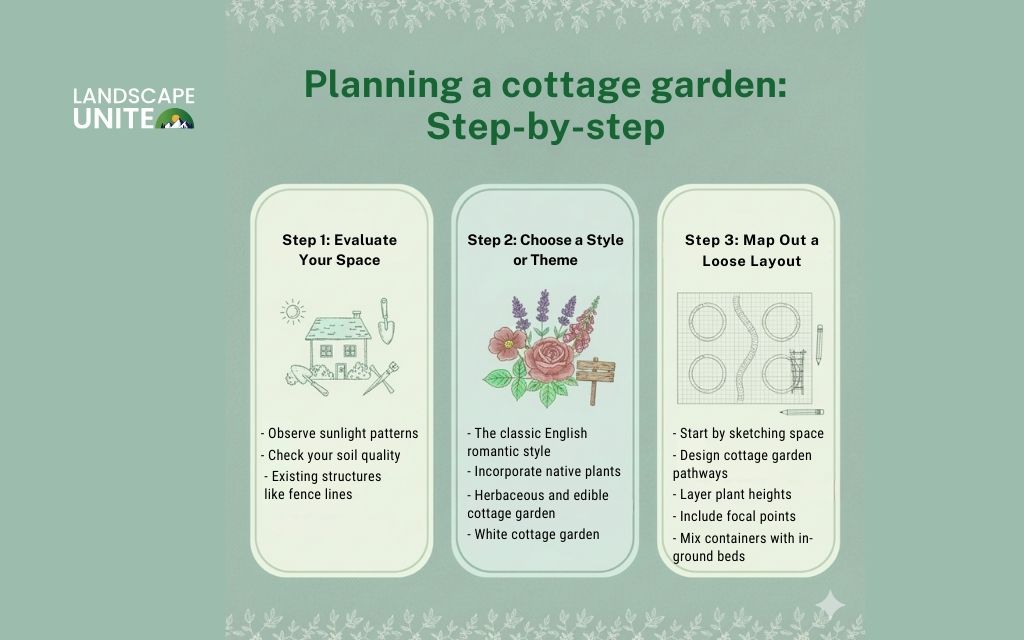
What plants should you pick for your cottage garden plans?
Plant selection makes or breaks your country cottage garden. Fortunately, cottage gardens welcome a generous mix of reliable workhorses and spontaneous volunteers.
Cottage garden flowers (Classic perennials & annuals)
These time-tested beauties form the backbone of traditional cottage flower beds:
Perennials
Perennials that return year after year include:
- Towering delphiniums in shades of blue and purple
- Romantic peonies with dinner-plate blooms
- Stately foxgloves (technically biennial but self-seeds readily)
- Cheerful black-eyed Susans
- Garden roses – especially David Austin varieties and old-fashioned shrub roses
- Classic hollyhocks, which create vertical drama along fences and walls.
Annuals
Annuals fill gaps and provide continuous color from spring through frost:
- Cosmos self-seeds and produces airy blooms in pink, white, and burgundy
- Sweet peas climb trellises with irresistible fragrance
- Zinnias offer bold color in every shade imaginable
- Nigella (love-in-a-mist) adds delicate texture and interesting seed pods
Herbs & edibles
Incorporating herbs honors cottage gardening tradition while adding fragrance and function:
- Lavender creates fragrant purple borders that attract pollinators
- Rosemary provides evergreen structure in mild climates
- Sage offers silvery foliage and purple blooms
- Thyme creeps between stepping stones, releasing scent when stepped on
- Chives produce pretty purple pom-poms in spring
- Ornamental kale adds sculptural interest in fall and winter cottage garden plans
Ground covers & fillers
These plants knit everything together, suppressing weeds while adding texture:
- Lamb’s ear (Stachys byzantina) offers velvety silver foliage that children love to touch
- Creeping Jenny spills from containers or fills cracks with chartreuse leaves
- Sweet alyssum edges beds with honey-scented white or purple blooms
- Catmint (Nepeta) creates billowing clouds of lavender-blue flowers
Climbing vines for vertical interest
Vertical elements maximize space and create that quintessential cottage garden look:
- Clematis comes in dozens of varieties with blooms ranging from dinner-plate size to delicate bells
- Climbing roses transform arches, fences, and pergolas into showstoppers
- Honeysuckle attracts hummingbirds with tubular flowers and fills evening air with perfume (choose non-invasive varieties suited to your region)
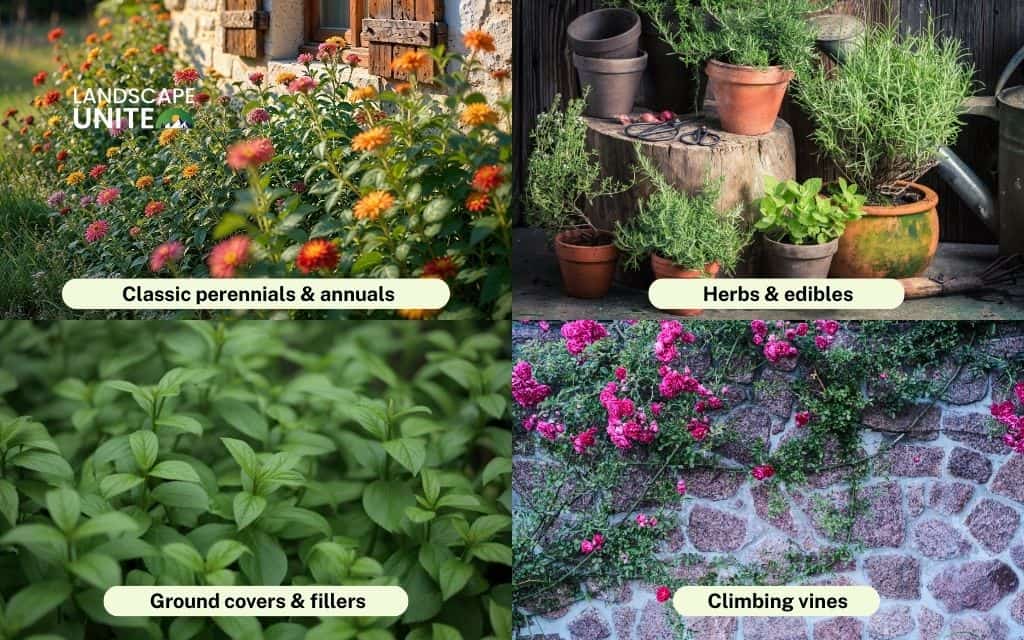
Benefits of a cottage garden
Beyond their undeniable beauty, cottage gardens offer practical advantages that make them ideal for modern gardeners.
- Low-maintenance once established: While the first season requires attention, mature cottage gardens largely care for themselves. Dense planting crowds out weeds, drought-tolerant perennials reduce watering needs, and self-seeding annuals return without replanting.
- Pollinator-friendly and eco-conscious: Cottage garden ideas support environmental health. The diverse plant palette provides nectar and pollen throughout the growing season, supporting bees, butterflies, and beneficial insects. Many cottage garden plants are native or well-adapted, reducing the need for chemicals and excessive water.
- Flexible in size: This adaptable style works beautifully whether you’re working with 6 square feet of balcony space or an acre of rural land. Small space gardeners can create stunning results with containers and vertical elements, while those with room to spread can design sweeping borders and multiple planting zones.
- Budget-friendly: Cottage gardening thrives on frugality. Start plants from seeds, divide perennials from friends’ gardens, shop end-of-season sales, and let self-seeders fill gaps. Many cottage garden stalwarts cost just pennies per packet and produce abundantly.
Sample cottage garden layout plans
Let’s translate theory into practice with three scalable cottage garden plans suited to different spaces.
Small space urban cottage garden (6×8 ft)
Perfect for renters, balcony gardeners, or those with limited yard space, this compact design proves you don’t need acreage for cottage charm.
- Layout: Install a vertical trellis (6 feet tall) along the back wall or fence. Position three large containers (16 – 20 inches) across the front. Add a narrow raised bed (12 inches deep) along one side if ground-planting is possible.
- Plants: Train clematis or climbing sweet peas up the trellis. Fill containers with a “thriller, filler, spiller” combination – try lavender as the thriller, annual geraniums as fillers, and trailing lobelia as spillers. Plant the raised bed with compact varieties: dwarf delphiniums, catmint, and lady’s mantle. Tuck herb containers (thyme, parsley, chives) wherever they fit.
- Result: A layered, lush display that maximizes vertical space while maintaining cottage garden abundance.
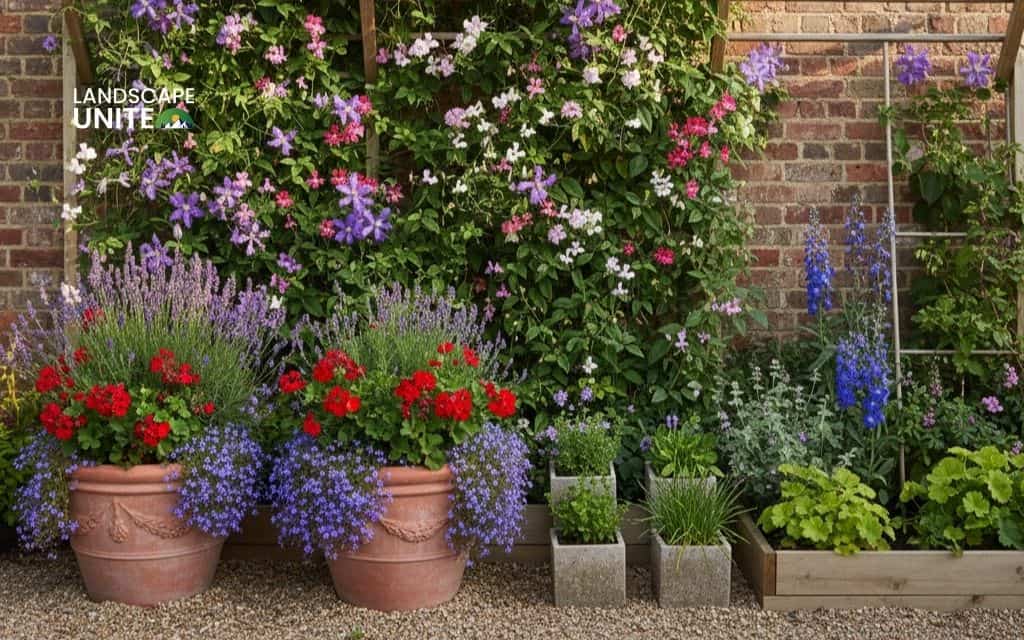
Classic rectangular flower border (10×3 ft)
This traditional border design works along fences, foundations, or as an island bed viewed from multiple sides.
- Layout: Create three horizontal zones – back (0 – 1 ft from fence), middle (1 – 2 ft), and front (2 – 3 ft).
- Plants – Back row: Alternate hollyhocks with climbing roses on the fence. Plant foxgloves in clusters of three between the taller plants.
- Middle zone: Interplant garden phlox, catmint, and Shasta daisies. Add clusters of irises for spring interest and sword-like foliage. Include Russian sage for late-season bloom.
- Front edge: Create a continuous border with lamb’s ear, interspersed with hardy geraniums and creeping thyme that softens the border’s edge.
- Result: Staggered bloom times ensure color from spring through fall, while varied textures create visual interest even when flowers fade.
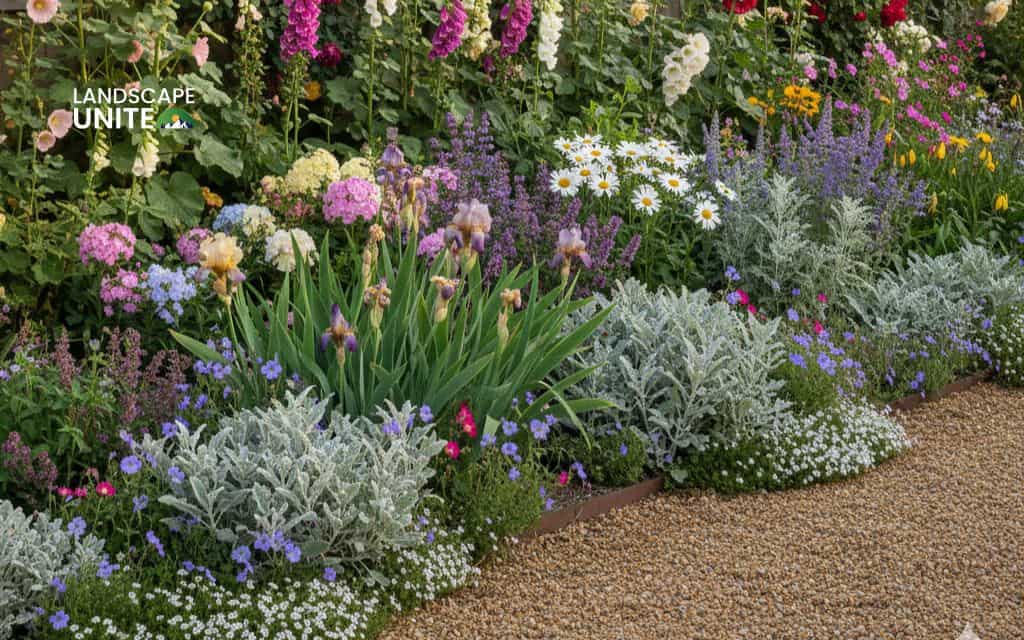
Corner lot full cottage garden (L-shaped)
For gardeners blessed with room to spread, this ambitious layout creates a destination rather than just a border.
- Layout: Design a curved gravel path that meanders through the L-shape. Install an arbor at the corner junction where the two legs meet. Create irregularly shaped beds on both sides of the path, varying from 4 – 8 feet deep.
- Plants: Under and around the arbor, plant fragrant climbing roses or wisteria. The largest beds include substantial plants like peonies (which provide structure even after blooming), ornamental grasses for movement, and repeat-blooming roses. Fill gaps with self-seeding annuals like cosmos, bachelor’s buttons, and California poppies.
- Add a small herb garden near the arbor. Edge all beds with low-growing plants that blur boundaries: lady’s mantle, catmint, and sweet alyssum.
- Result: An immersive garden experience with multiple vantage points, seasonal surprises, and room to experiment with new plants each year.
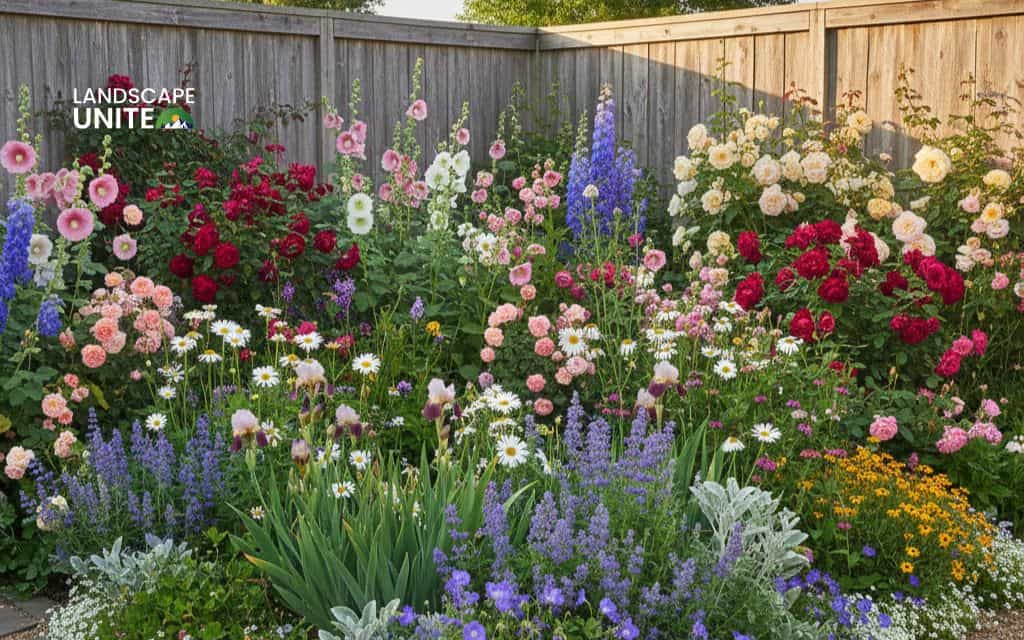
Design tips for a beautiful cottage look
Mastering the cottage aesthetic requires understanding the difference between “artfully casual” and “genuinely messy.”
- Plant densely, but not chaotically: Cottage gardens thrive on abundance, with plants touching and interweaving. However, controlled chaos is key. Group plants in odd numbers (3, 5, 7) rather than scattering single specimens. This creates impact while maintaining some order.
- Repeat colors and textures for cohesion: Planting a cottage garden successfully means creating rhythm through repetition. If you use purple catmint in one corner, echo it in 2 or 3 other spots. Repeat silver foliage plants throughout to unify diverse plantings. This prevents the garden from feeling like a random collection.
- Let self-seeders naturalize (but monitor spreading): Part of cottage garden magic comes from volunteers – plants that self-seed in unexpected but delightful spots. Encourage this by leaving some spent flower heads on foxgloves, nigella, and calendulas. However, stay vigilant about thugs that spread aggressively. Pull unwanted seedlings early, while they’re manageable.
- Combine blooms with foliage plants for year-round interest: A garden that relies solely on flowers looks bare in winter. Include plants valued for foliage – artemisia’s silver leaves, heuchera’s colorful rosettes, ferns’ architectural fronds. These provide structure and beauty between bloom times.
Add seasonal bulbs for early interest. Tuck daffodils, tulips, and alliums between perennials. As bulb foliage fades, emerging perennial growth disguises the dying leaves.
Conclusion
Creating cottage garden plans doesn’t require perfection—it invites experimentation, celebrates happy accidents, and improves with each passing season. Your garden will evolve as plants mature, self-seeders surprise you, and you discover what thrives in your unique conditions.
Start small if you’re feeling overwhelmed. Begin with one border, a few containers, or even just a selection of easy cottage favorites like cosmos, zinnias, and catmint. As your confidence grows, expand your beds, experiment with new plants, and develop your personal cottage gardening style.
Ready to begin? Start with our cottage garden plans above, then explore our full collection of garden guides for more ideas.
Frequently asked questions (FAQs)
What is the best time to start a cottage garden?
Spring and fall are ideal for planting cottage gardens. Spring allows you to plant annuals and summer-blooming perennials, while fall is perfect for establishing perennials and planting spring bulbs. However, you can start planning and preparing beds any time. Begin designing in winter, prepare soil in early spring, and plant throughout the growing season for fastest results.
Do cottage gardens work in hot, dry climates?
Yes! Choose drought-tolerant cottage favorites like lavender, Russian sage, yarrow, salvia, and coreopsis. Mediterranean herbs (rosemary, thyme, oregano) thrive in heat with less water. Mulch heavily to retain moisture and embrace native plants suited to your climate. The key is selecting plants that naturally thrive in your conditions rather than fighting them.
Can I have a cottage garden without flowers?
Absolutely! Create a foliage-focused cottage garden using silvery artemisia, colorful heuchera, variegated hostas, ornamental grasses, and ferns. Add structure with boxwood, lavender, and rosemary. Include edible plants like kale, chard, and purple cabbage for color. This approach offers year-round beauty with less maintenance than bloom-focused designs.
What are the best low-maintenance plants for a cottage garden?
Choose tough perennials like daylilies, catmint, sedum, Russian sage, black-eyed Susans, and lady’s mantle. These plants establish quickly, tolerate various conditions, and return year after year with minimal care. Add self-seeding annuals like cosmos, calendula, and bachelor’s buttons that return without replanting for effortless color.
Can I grow a cottage garden in containers?
Yes! Container cottage gardens work beautifully for small spaces and renters. Use large containers (at least 16 inches diameter) and combine plants with height (lavender, small roses), mid-level interest (geraniums, verbena), and trailing elements (lobelia, bacopa). Group containers at varying heights and add a small trellis for climbing plants.
